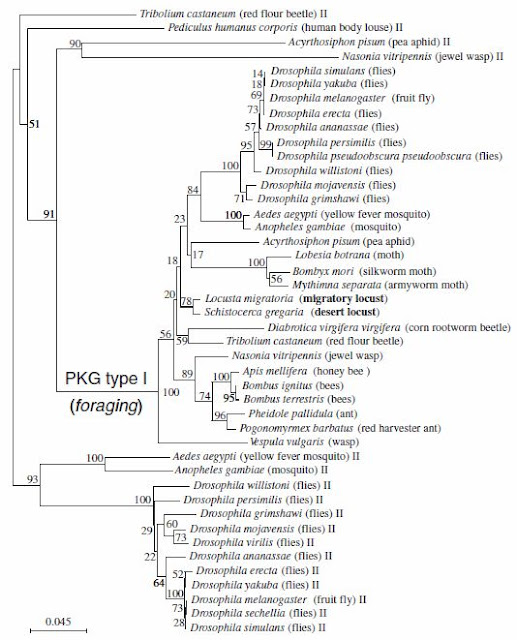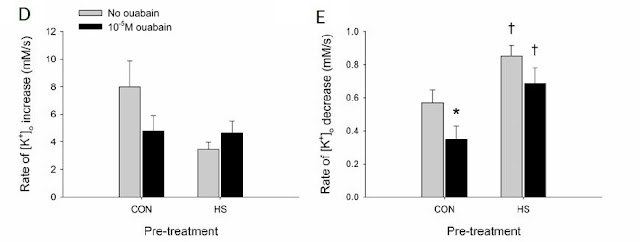Most variations between conspecifics are often caused by simple differences in their enzymatic activities. These differences then in turn allow for evolution of the species. I came across this paper on variations in thermotolerance in fruit flies and locusts when one of the past PhD students, Gary, recently asked to me collect some additional data for one of his upcoming papers. To gain a better understanding in Gary’s field of study before the data collection, I read one of his prior publications from 2007.

In this paper, Gary and his colleagues manipulated the foraging gene (for), and its downstream pathways in locusts and fruit flies to examine their effects on the animals' ability to maintain neural and behavioural thermotolerance.
It has been illustrated that natural allelic variation in for gave rise to rover, forR, and sitter, forS in D. melanogaster larval foraging behaviours. Rovers are described as those larvae that moved more than sitters when feeding, and have higher PKG transcript levels and activities. The function of for in behaviour is said to be conserved across most organisms including ants, bees, nematodes, and mammals. In addition, for is also known to encode a cGMP-dependent protein kinase (PKG).
Thus, researchers hypothesized that the polymorphism in for can provide populations with natural variation in heat stress tolerance, and the variations in for and the differences in PKG levels could contribute to natural variations which might impact the evolution of thermotolerance in natural populations. .
Thus, researchers hypothesized that the polymorphism in for can provide populations with natural variation in heat stress tolerance, and the variations in for and the differences in PKG levels could contribute to natural variations which might impact the evolution of thermotolerance in natural populations. .
 |
| This graph illustrated that forS2 had the highest thermotolerance amongst the 3 variants, whereas the variant that has the highest PKG activity, forR displayed the lowest heat-tolerance. |
In this paper, researchers first examined whether different thermotolerance levels existed between Drosophila for variants. During these experiments, researchers increased temperature systematically and recorded the heat-tolerance failure point indicated by the cease in larval mouth hook movements. Three different types of for variants were used during this set of experiments. forR, forS, and forS2, which is a line of sitter mutant generated on a rover genetic background.
From these experiments, researchers found that forS2 illustrated a significantly higher failure temperature than forS and forR, and that forS and forS2 demonstrated a significantly higher synaptic transmission failure temperature than forR. This suggests that a lower PKG activity from the two forS variants could correspond to an increase in thermoprotection.
To confirm this hypothesis, researchers pharmacologically manipulated the PKG pathway by adding a cell-permeable PKG-specific inhibitor KT5823 and activator 8-Bromo-cGMP to Drosophila larvae. They found that the inhibition of the PKG pathway by KT5823 significantly increased the synaptic failure temperature in all three for variants, while PKG activation significantly decreased thermotolerance.
Researchers also explored the downstream effectors of PKG in thermotolerance by studying PP2A, which also affects K+ channels. PP2A is phosphorylated by PKG, which then in turn de-phosphorylates specific K+ channels. In this study, researchers noticed that a PP2A-specific inhibitor, Cantharidin increased the thermotolerance of synaptic transmission as strongly as the PKG inhibitor KT5823. Thus, they confirmed that there is a negative relationship between PKG activity and the thermotolerance in Drosophila larvae.
From these experiments, researchers found that forS2 illustrated a significantly higher failure temperature than forS and forR, and that forS and forS2 demonstrated a significantly higher synaptic transmission failure temperature than forR. This suggests that a lower PKG activity from the two forS variants could correspond to an increase in thermoprotection.
To confirm this hypothesis, researchers pharmacologically manipulated the PKG pathway by adding a cell-permeable PKG-specific inhibitor KT5823 and activator 8-Bromo-cGMP to Drosophila larvae. They found that the inhibition of the PKG pathway by KT5823 significantly increased the synaptic failure temperature in all three for variants, while PKG activation significantly decreased thermotolerance.
Researchers also explored the downstream effectors of PKG in thermotolerance by studying PP2A, which also affects K+ channels. PP2A is phosphorylated by PKG, which then in turn de-phosphorylates specific K+ channels. In this study, researchers noticed that a PP2A-specific inhibitor, Cantharidin increased the thermotolerance of synaptic transmission as strongly as the PKG inhibitor KT5823. Thus, they confirmed that there is a negative relationship between PKG activity and the thermotolerance in Drosophila larvae.
Moreover, researchers also studied the interaction between heatshock pretreatments and PKG pathways. In this set of experiments, by examining the effect of a PKG activator, 8-Bromo cGMP on heatshocked locusts, researchers concluded that there was no significant difference between the failure temperature and the recovery time in control locusts that were treated with and without 8-Bromo cGMP. However, the heatshock induced heat-tolerance was abolished by the application of 8-Bromo cGMP.
Furthermore, when compared with control locusts, the simultaneous addition of both PKG activator and the PP2A inhibitor in HS animals resulted in maximal thermotolerance of failure temperature and minimal recovery time. These outcomes indicated that PP2A is likely acting downstream from PKG and interacting with the same pathway affected by heatshock pretreatment.
Furthermore, when compared with control locusts, the simultaneous addition of both PKG activator and the PP2A inhibitor in HS animals resulted in maximal thermotolerance of failure temperature and minimal recovery time. These outcomes indicated that PP2A is likely acting downstream from PKG and interacting with the same pathway affected by heatshock pretreatment.
In conclusion, this study determined that reduced PKG activity in forS resulted in greater thermotolerance, which can be replicated pharmacologically by using a PKG inhibitor, KT5823. In addition, the PP2A pathway is found to be downstream from the effects of heatshock and the PKG pathway, but upstream from the effects of K+ channels. These findings confirm the hypothesis that the polymorphism in for can indeed provide populations with natural variation in heat stress tolerance.
I really enjoyed this paper because of those very well designed experiments Gary et al. conducted in this study. However, one drawback of this publication was the redundancy of information in the figures, which made the result section seemed sloppy and confusing.
I really enjoyed this paper because of those very well designed experiments Gary et al. conducted in this study. However, one drawback of this publication was the redundancy of information in the figures, which made the result section seemed sloppy and confusing.
Reference: Dawson-Scully, K., Armstrong, G.A.B., Kent, C., Robertson, R.M., Sokolowski, M.B., 2007. Natural Variation in the Thermotolerance of Neural Function and Behaviror due to a cGMP-Dependent Protein Kinase. PLoS ONE 8:e773












